Frontenac Arch
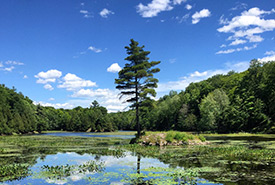
A wetland in the Frontenac Arch, ON (Photo by NCC)
Help protect a key wildlife corridor
If you look at a night image of northeastern North America from space, you see the lights of cities, towns and highways spreading like a constellation across the landscape. Yet just north of Kingston and northeast of the St. Lawrence River is an archipelago of countryside and wilderness under dark skies and bright stars.
This is the Frontenac Arch — over 171,000 hectares (423,000 acres) of forests, wetlands and lakes, home to thousands of species.
Connecting the northern forests of Algonquin with the Adirondacks in New York State, the Arch forms a critical habitat linkage between the northern hardwood and mixed forests of Ontario and the Appalachian Mountain chain of eastern North America. This narrow bridge is one of the most important forest corridors east of the Rocky Mountains.
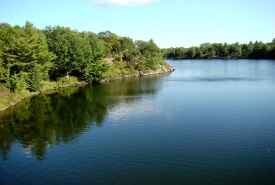
Elbow Lake, Frontenac Arch, ON (Photo by NCC)
The landscape has a long history, both human and natural. The Frontenac Arch is on the traditional territories of the Anishinaabe and Haudenosaunee. After the War of Independence and War of 1812, this was one of the first places settled by early Empire Loyalists. During this time, many Indigenous Peoples relocated to the Frontenac Arch from other areas due to the upheaval brought about by war. With gratitude and respect, we acknowledge the significant contributions Indigenous Peoples have, and continue to make, on these lands.
The rocky vistas, lakes and forests make the Frontenac Arch quintessential Ontario wilderness and a place of great beauty. The area brings together the northern Canadian Shield forests and southern Carolinian influences. This overlap creates a richness of plant, insect and animal species. Over 200 bird species alone have been recorded at the Queen’s University Biological Station inside the Arch.
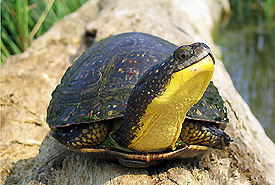
Blanding's turtle, Frontenac Arch Natural Area, Ontario (Photo by Ryan M. Bolton)
Home to many at-risk and globally rare species, the Arch serves as a funnel for migrating birds, bats and insects. It also provides habitat for animals with large home ranges, such as fisher, black bear, moose and eastern wolf. The area’s incredibly rich natural environment and history was recognized in 2002 when it became a UNESCO World Biosphere Reserve; part of a world-wide network of 701 Biosphere Reserves in 124 countries.
What the Nature Conservancy of Canada is doing
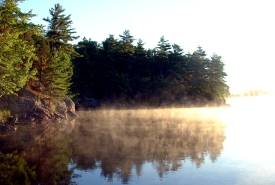
Misty morning on the Frontenac Arch, Ontario (Photo by NCC)
The Nature Conservancy of Canada (NCC) has been making targeted efforts in the Frontenac Arch for over a decade, securing key properties and assisting partners in their conservation efforts. NCC currently owns and manages over 2,760 hectares (6,835 acres) here. In addition, NCC has assisted with an additional 2,985 hectares (7,376 acres) of protected habitat in the area.
About 11 per cent of the Frontenac Arch is currently under provincial or federal regulation, or is conservation land. NCC’s long-term vision for the area is to help create a connected mosaic of protected lands across the Arch, with at least 17 per cent under some form of conservation protection.
Partnerships and careful, long-term planning have been critical to our success. NCC works closely with the following partners in the area:
- Queen’s University Biological Station
- Algonquin to Adirondacks Collaborative
- Land Conservancy for Kingston, Frontenac, Lennox & Addington
- Thousand Islands Watershed Land Trust
- Rideau Waterway Land Trust
- Frontenac Arch Biosphere Reserve
- and other partners
NCC has an opportunity to protect 83 hectares (205 acres) on the Arch, between Devil Lake and Benson Lake. If protected, this property will connect to a network of existing conservation land owned by NCC and partners, including Queen's University. Your gift will help protect the Frontenac Arch, forever.
DONATE TODAY!
Quick facts
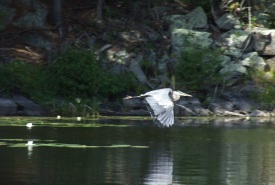
Great blue heron, Rock Lake, Frontenac Arch, Ontario (Photo by NCC)
Location: the Frontenac Arch runs through southeastern Ontario and upstate New York from Westport, north of Kingston, through the Thousand Islands to the Adirondack Mountains
Habitat type: forests, wetlands, shoreline, rock barren
Species: Blanding’s turtle, cerulean warbler, whip-poor-will, gray ratsnake
Current Priority
Size: 83 hectares (205 acres)
Estimated project cost: $550,000
A natural legacy
When it comes to conserving Canada’s most important natural areas, buying land is just the beginning. Stewardship — managing the land for the long term — is at the heart of what we do. Each and every property we protect is monitored and managed, so that the ecosystems are maintained and species thrive, even if that means leaving it be. This can include mapping and removing invasive species, restoring wetlands, grasslands and forests, monitoring for species at risk, planting native species, building trails or installing signage.
In order to continue to care for the natural areas we protect, NCC has created a Stewardship Endowment Fund. This fund provides annual support for our priority stewardship work across Ontario. Annual benefits from the endowment fund are used to pay the costs necessary to ensure efficient and long-term, science-based management of lands under NCC’s care.
NCC may direct all or a portion of gifts committed to this project to NCC’s Stewardship Endowment Fund for Ontario. Revenue generated by the Stewardship Endowment Fund provides for long-term management on properties across the province, including NCC conservation lands in the Frontenac Arch. In the event that this project becomes fully funded or cannot be carried out, your gift will be allocated to the next urgent priority in this natural area.




